Double Star of the Month Archive 2024
In this series of short articles, a double star in both the northern and southern hemispheres will be highlighted for observation with small telescopes, with new objects being selected for each month.
December 2024 - Double Star of the Month
STF 430 Tauri (03 40 28.04 +05 07 33.2) is a coarse and unequal triple star found 1.5° WSW of 29 Tauri. The AB consist of stars of visual magnitude 6.8 and 9.8 separated by 26" at a PA of 57 degrees.
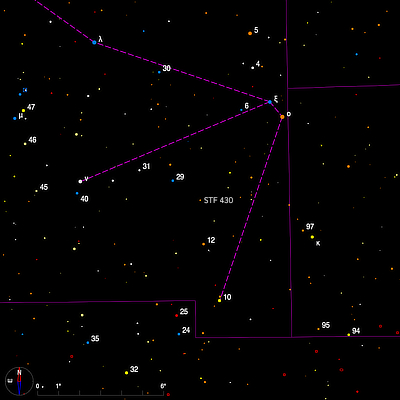
The primary is a K2III and appears distinctly orange in the eyepiece. An observation made with a 10-inch mirror at x48 showed that B is blue as is the further companion, C, which is 34" away and is somewhat fainter than B.
Although A and B have similar parallaxes they are not the same within the errors quoted in the Gaia DR3 catalogue, and actually the faintest star is much closer to us than the other stars.
In southern Eridanus near the border with Caelum lies 41 Eridani (04 17 53.62 -33 47 54).
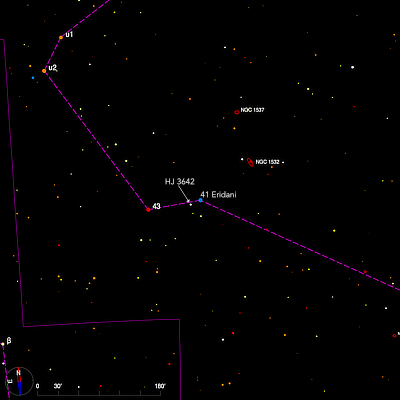
This is a star which has an unusual chemical composition which contains significant amounts of mercury and manganese. Such stars are found to be common in spectroscopic binary systems and in 2012 a team using the VLTI in Chile resolved 41 Eri into two with a period of 5 days and a separation of a few milli-seconds of arc.
A century before, however, Robert Innes, using a 7-inch refractor from the Cape of Good Hope, found the star to be a close double bright (I 270) with magnitudes of 3.6 and 4.
The pair began to close in and were last seen in 1933 when the distance was 0".1. Later attempts to resolve the stars have failed - between 2017 and 2019, Dr. Andrei Tokovinin was unable to see the companion using a 4-metre telescope and it is now supposed that this is not a visual double star.
In 1836 John Herschel found a faint companion (HJ 3636 AC) about 60" distant and gave the magnitudes as 3 and 14. Today the WDS gives magnitudes of 3.9 and 11.8 with PA and separation of 8 degrees and 49".
Whilst in the area check out another HJ pair, no. 3642 just a few arc-minutes SSE - 6.6, 8.7, 157 degrees, 5".2.
Bob Argyle - Double Star Section Director
November 2024 - Double Star of the Month
George Knott was a Victorian amateur astronomer with an interest in double stars. Using a 7.3-inch Clark refractor which once belonged to W. R. Dawes at his observatory in Cuckfield, West Sussex, he made a number of discoveries, five of which can be found in the current Washington Double Star catalog.
The primary star of KNT 1 (01 02 18.34 +81 52 32.1) is the variable star U Cephei. It is an eclipsing binary with a period of 2.5 days and in mid-eclipse the star drops by almost three magnitudes. At maximum, it is V = 6.7 and has a faint companion of magnitude 11.8 some 14" distant in PA 63 degrees.
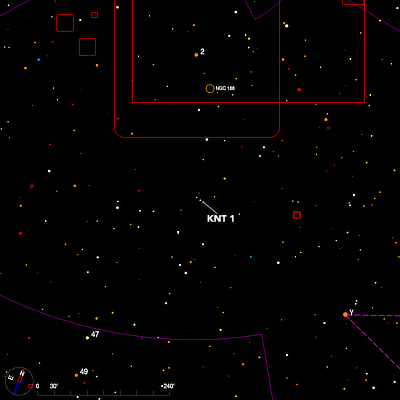
Rather surprisingly both stars lie at the same distance (632 light-years) and have very similar proper motions. A slighter fainter, and definitely unconnected, third star can be found at PA 315 degrees (increasing) and 24" (decreasing).
Another pair of stars with a variable primary is HJ 3476 (02 00 26.77 -08 31 25.8). This is AR Cet which is probably a semi-regular variable. John Herschel swept them up from Feldhausen and noted Large star very yellow
. The primary is an M3 giant and its catalogue magnitude is given as 5.7 with the companion 61" away in PA 202 degrees. Herschel noted magnitudes 6 and 10.

The position angle has reduced 20 degrees since discovery but this is due to the proper motion of the primary star which is 536 light-years away whilst its faint companion lies 2160 light-years distant.
HJ 3476 lies about 3 degrees NE of zeta Cet which is also known as Baten Kaitos. This, too, is a very unequal and wide double with the components of 3.8 and 10.5 being divided by 106".
Bob Argyle - Double Star Section Director
October 2024 - Double Star of the Month
In the north of Andromeda near the border with Cassiopeia and close to the line of zero RA lies 22 And, a star of visual magnitude 5.0. Moving about one degree west and slightly south brings us to BU 997 (00 04 57.53 +45 40 25.6), a pair of stars of magnitudes 7.6 and 9.4 and currently 3".8 apart. They should be easily seen in 15-cm although they were discovered by S. W. Burnham with the Dearborn 18.5-inch refractor. The stars show little motion, apart from a slight reduction in the pair's separation.
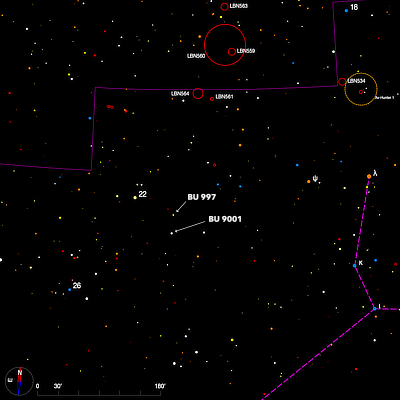
In addition to his numbered discoveries, Burnham also noted a number of wide, faint pairs which have since been placed into the Washington Double Star catalog. One of these, BU 9001 (formerly BU 997a but renumbered to fit in with the new format of three letters and four numbers) lies about 30' due south. The stars are very unequal (6.7 and 10.6) and the companion lies at 235 degrees and 21". Larger apertures might see the 13.7 star added by Thomas Espin in 1914 at 107 degrees and 16".
LAL 192 (23 54 21.40 -27 02 34.5) is another example of a pair being re-catalogued. It appeared in Dunlop's catalogue of 1826 as DUN 253 but was apparently changed to its current moniker at Lick Observatory when the double star catalogue existed on index cards but no-one seems to know why. It is, in any case, well worth seeking out. Easily seen in 10-cm the 6.8 and 7.4 magnitude components are presently 6".5 apart, a distance which is slowly increasing. Ross Gould using 10-cm records colours of pale yellow with a slight difference in shade
.
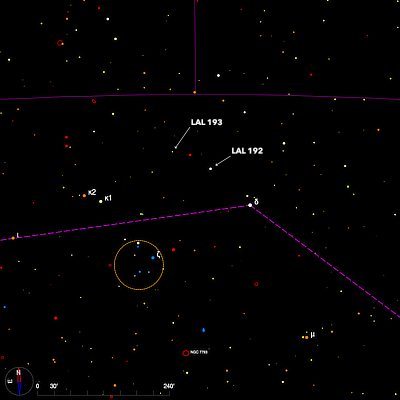
LAL 193 is in the neighbourhood. It is 1.5 degrees ENE of LAL 192 and the magnitude 6.2 SAO 192262, a distinctly orange-hued star lies between the two. LAL 193 consists of two early-F dwarfs of magnitudes 8.1 and 8.3. The current separation and position angle are 19".4 and 169 degrees and they also appear to comprise a physical system.
Bob Argyle - Double Star Section Director
September 2024 - Double Star of the Month
Just two and a bit degrees north of the Saturn Nebula (NGC 7008) is the long period binary STF 2751 (21 02 09.00 +56 40 11.1). This pair of white stars should be divided easily in 10-cm and may be split in a good 7.5-cm aperture.

Since 1828 when an early measure by the discoverer F G W Struve gave 343 degrees and 1".5 the stars have now moved on to 356 degrees and 1".6. Gaia DR3 indicates that the stars are at the same distance from us at least within the formal quoted errors. They lie 1,100 light-years away and are moving across the sky at close to 0".1 per year.
Three degrees due south of the first magnitude Achernar in Piscis Austrinus is delta PsA (22 55 56.89 -32 32 22.9) which was found to be double by Herbert Howe in Cincinnati in 1876 and is number 91 in his catalogue, although the Washington Double Star catalog (WDS) also call this system BU 772 which reflects an independent, but later, discovery by S. W. Burnham.
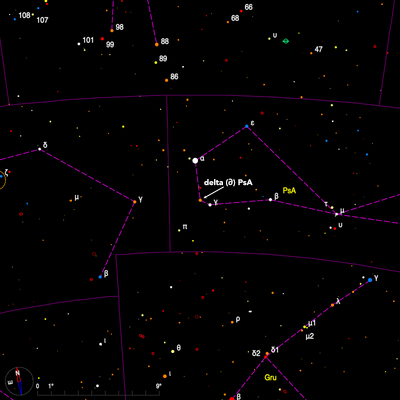
The WDS gives magnitudes of 4.3 and 9.3 whilst the Gaia DR3 catalogue records G magnitudes (similar to visual) of 3.9 and 9.8. As the current separation is 4".7 this is a pair which needs a night of steady seeing and, given its very low declination from the UK, probably 15-cm aperture. The stars appear to form a physical system and are 171 light-years away. Both beta PsA and gamma PsA are pairs with bright primaries and considerably fainter comites (see this column for Oct 2016 and Oct 2012 respectively).
Bob Argyle - Double Star Section Director
August 2024 - Double Star of the Month
33 Cygni lies in northern Cygnus, near the border with both Cepheus and Draco. It forms one apex of a triangle whose sides are 1.5 degrees long with two other stars, both of which are visual doubles. The star which is directly east of 33 is STF 2687 (20 26 23.47 +56 38 19.3). This is an easy pair for the small aperture with the stars of magnitudes 6.3 and 8.1, separated by 25".
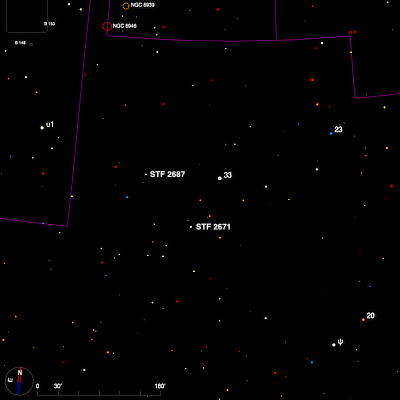
The other member of the triangle is STF 2671 (H I 95). This is a brighter but closer pair than STF2687. The main components have magnitudes 6.1 and 7.5 and the current position of the fainter component is 337 degrees and 3".8, coordinates which have changed very little over 200 years. There is a 12.4 magnitude star at 53 degrees and 90" and two further 13th magnitude field stars.
The second edition of The Cambridge Double Star Atlas shows the pair HJ 2975 in Capricornus about 5 degrees south of, and slightly following, the bright triangle of visual double stars formed by omicron (ο) Cap, rho (ρ) Cap, and pi (π) Cap (see this column for August 2015, 2016 and 2017 respectively). It is a fairly difficult pair for small telescopes as the Washington Double Star catalog (WDS) gives magnitudes of 7.5 and 11.6 and a separation of 11".
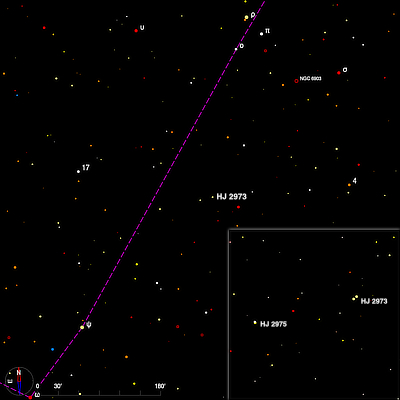
The Atlas also shows that the star immediately north preceding by about 30 minutes is also double. This is a brighter and easier object (magnitudes 7.8 and 8.1) which does not warrant a label because the stars are 39" apart, but it is HJ 2973 (20 32 13.27 -22 09 17.6), a pair of yellowish F stars, one of which was found to be a close double at a lunar occultation in 1983.
These Herschel pairs were discovered using the 20-foot reflector from Slough in 1830/1, and John Herschel allocated magnitudes of 8 and 14 to HJ 2975 and 8.9, 8.9 to HJ 2973.
Bob Argyle - Double Star Section Director
July 2024 - Double Star of the Month
The constellation of Draco is draped across 11 hours of Right Ascension and perhaps the most distinctive part of it are the four stars which form the head of the beast. The faintest of these, and the most north-westerly is nu Dra (17 32 16.04 +55 10 22.5). Even a small pair of binoculars will show that it is really two equally bright, white gems, both of visual magnitude 4.9. Discovered in 1690 (by Flamsteed) this beautiful pair is worth seeking out in any aperture.
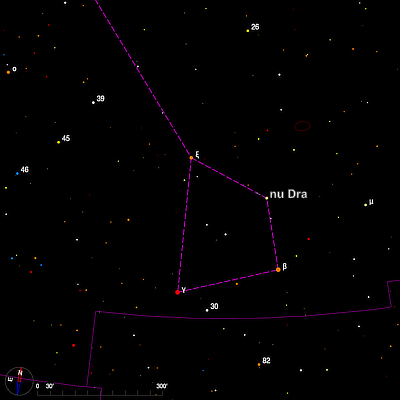
The separation is slowly decreasing with time but at the time of writing is still a generous 62". Gaia EDR3 indicates that the stars are essentially at the same distance (98 light-years) and have very similar proper motions. This object forms one of the calibrating standard pairs which I use to convert the settings of the micrometer on the 8-inch Cooke telescope at Cambridge to position angles in degrees and separation in arc-seconds on the sky.
Meanwhile, the stars of Ara sit south of Scorpius and the brighter members resemble a `butterfly' shape. Beta and gamma Ara, at the head of the butterfly, sit a degree apart and have distinctly different hues, thus creating a fine view in binoculars. Beta is red and gamma is blue whilst 4 degrees due south is 3.6 magnitude delta Ara (17 31 05.96 -60 41 01.8).
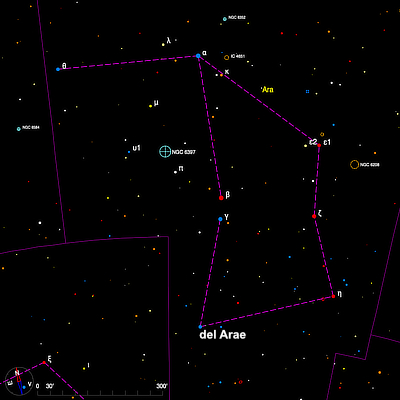
John Herschel noted a distant and faint companion (V = 11) some 40" away and entered the pair as number 4951 in his catalogue. The companion should be visible in 10 or 15-cm and is now somewhat better placed having eased out to a distance of 50".4 in 2016. In 2010 a project involving deep infra-red imaging of stars which may have sub-stellar companions revealed 3 images within 12" whose K magnitudes were between 12 and 14.
Bob Argyle - Double Star Section Director
June 2024 - Double Star of the Month
STF 1984 (15 51 10.09 +52 54 25) lies in south-eastern Draco almost on the border with Boötes in a rather featureless part of the sky, which may be why I have no record of observing this pair during my early visual survey.
I did make a measure with the 8-inch Cambridge Cooke telescope giving 279 degrees, 6".4 in late 2009. An aperture of 10-cm should show the two stars which form this system - the magnitudes are 6.9 and 8.9.
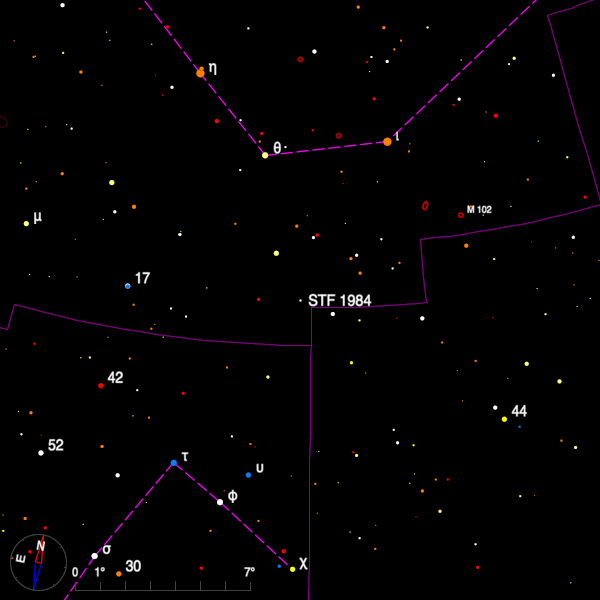
Although Gaia DR3 places the stars at similar distances (around 370 light-years), the formal errors on the parallaxes are significantly smaller than the parallax difference between the components, so whether the stars form a binary system is open to some doubt.
In May 1874 S. W. Burnham was observing stars in Scorpius with his 6-inch Alvan Clark refractor and more specifically he was looking for HJ 4756 - a close pair discovered by John Herschel some 40 years earlier. He found a pair which vaguely resembled the HJ pair but its position did not correspond very well to the catalogue position so Burnham called the pair BU 228. He later realized that this was indeed the Herschel pair HJ 4756 (15 19 40.37 -24 16 11.9).
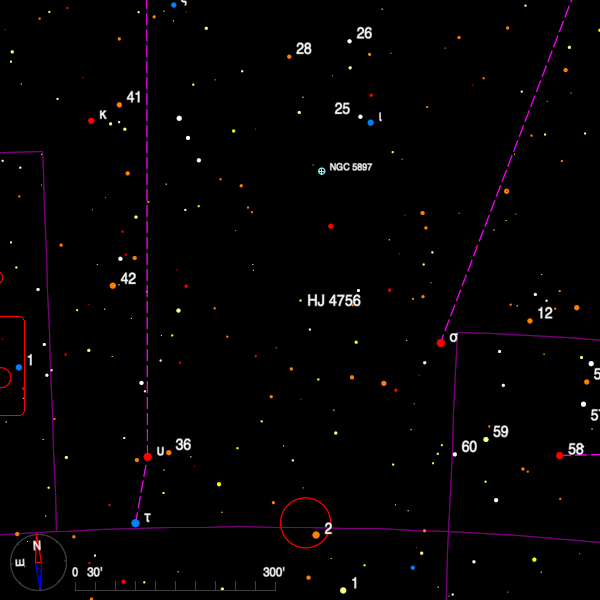
The stars are magnitudes 7.9 and 8.3 and are currently slowing closing in a 500-year orbit. The current position is 229 degrees and 0".65 so a 25-cm telescope will be needed and more importantly, if observing from Europe, a night of high quality.
Some 30 seconds of RA directly preceding is BU 227, an easier pair which drew from Burnham the comment that It is singular that he (Herschel) should have missed the other pair
i.e. this one. The stars have magnitudes 7.5 and 8.6 and are currently 2 arc-seconds apart in PA 160 degrees, so should be divisible in 10—15 cm. The stars can be found 3 degrees ENE of sigma Lib.
Bob Argyle - Double Star Section Director
May 2024 - Double Star of the Month
STF 1834 (14 20 17,6 +48 30 25.1) sits in the north of Boötes, about half way between theta and lambda Boo and 2.5 degrees north north-east of the latter.

It is a well-known binary and the Washington Double Star catalog (WDS) notes than 250 direct measurements have been since discovery by Struve at Pulkova. From about 1830 to 1900 the two stars, magnitudes 8.1 and 8.3, closed steadily from 1".7 but then in just a few years the companion swung around its partner at which point it was out of range of even the large refractors of the time and began heading out towards the discovery position.
The period of the pair is 413 years and at the present time the position angle and separation are 204 degrees and 1".7. The relative faintness of the stars would suggest that an aperture of 15-cm would be better to view them.
About 1 degree south-east is STF 1843, a pair of stars of magnitude 7.7 and 9.2 currently at 186 degrees and 19".8. The stars lie at a similar distance and have common proper motion.
Near the border of Libra with Lupus, HJ 4774 (15 28 58.69 -28 52 00.5) was discovered by John Herschel from Feldhausen during his stay at the Cape of Good Hope. The brightest star is magnitude 7.0 and has a 9.6 magnitude companion almost 10 arc-seconds distance in PA 11 degrees.

In 1889 the eagle-eyed S. W. Burnham found that the primary star was double again with a 7.7 magnitude star at a distance of 0".7. Since then the separation of the close pair has closed to 0".1. A recent orbit by Dr. Andrei Tokovinin indicates that the orbit is only 0.6 degrees from being edge-on and in 2027 when periastron occurs the two stars will be only 8 milliarcseconds apart.
Bob Argyle - Double Star Section Director
April 2024 - Double Star of the Month
STF 1645 (12 28 04.45 +44 47 39.5) is a fine pair in Canes Venatici found 3.5 degrees WNW of beta CVn (chara) and also 3/4 degrees north of the galaxy NGC 4449.
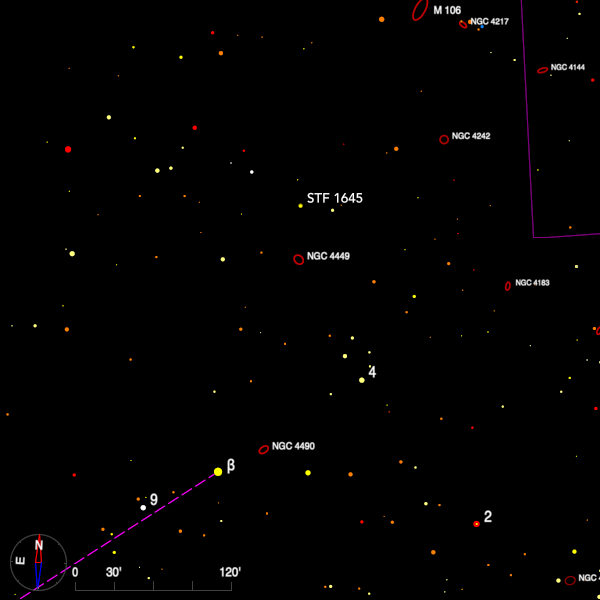
T. W. Webb, in Celestial Objects for Common Telescopes reports an observation by Bird, a Victorian amateur astronomer, as a lovely pair as I ever saw
. Webb also calls them yellow which chimes with the spectral types of F9V and KV given in the Washington Double Star catalog (WDS). In 1972 using a 10-in (25-cm) Newtonian I made the colours yellow and blue, whilst Sissy Haas using a 60-mm refractor finds both are peach-white.
The stars have visual magnitudes of 7.5 and 8.1 and they are currently at 156 degrees and 9".8, but the stars were 16" apart when found by William Herschel in 1791. Nevertheless they both appear to be 147.7 light-years from the Earth and are moving almost directly south on the celestial sphere at the rate of 0".2 per year.
Two degrees north of iota Librae is a coarse triangle of stars. The most north-westerly of this trio is SHJ 195 (15 14 28.13 -18 25 42.7) which again, despite the catalogue name, was discovered by William Herschel.
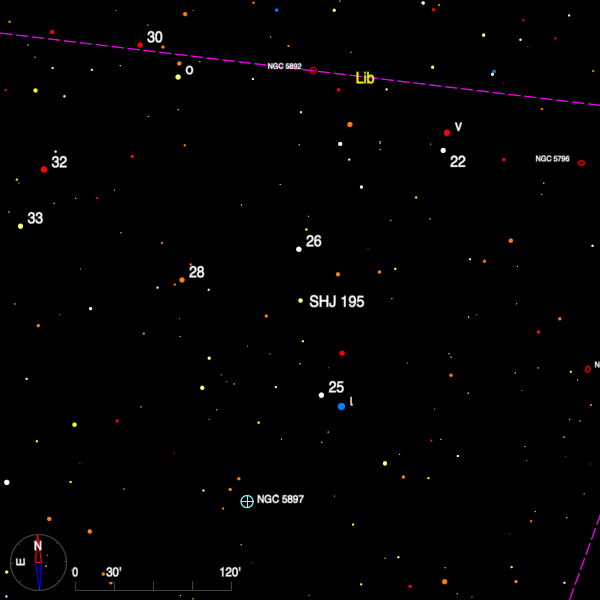
Again this is a pair of F5 stars whose visual magnitudes are given as 7.5 and 8.1 in the WDS, which Admiral Smyth described as white and bluish. Although low in the Cambridge sky, I made a pair of measures in 2009 with the result 140.3 degrees, 45".59.
Gaia EDR3 records parallaxes that are the same within the quoted errors, although the error of the bright star's parallax is some ten times larger than the typical value for that magnitude. The proper motions are also very similar - the stars are moving at 0".1 per year.
Bob Argyle - Double Star Section Director
March 2024 - Double Star of the Month
In a sparse area of sky south of Ursa Major a faint triangle of naked-eye stars can be seen. They straddle the border between Lynx and Leo Minor. The north-eastern of these stars is 38 Lyncis (09 18 50.64 +36 48 09.3), a beautiful pair whose components are magnitudes 3.9 and 6.1 and whose position angle has reduced just 15 degrees in the 200 years since the pair was first measured. The separation is 2".6 so a moderate magnification needs to be used to separate the stars adequately.
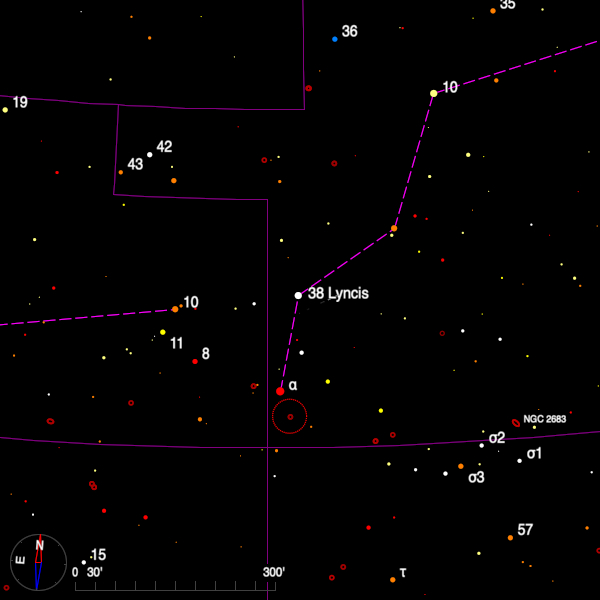
An orbit with a period of 2782.8335 years, published in 2019, needs to be regarded with some scepticism but the stars are certainly physical, as shown by the parallaxes which the Gaia satellite has provided. Speckle interferometry reveals that B is a very close pair with two observations only and a measured separation of 0".1 to 0".2, and the Washington Double Star catalog (WDS) indicates that the A component is a 2 day eclipsing binary, found by the TESS satellite.
There are optical companions (C,D) at 79" and 173" respectively, both of magnitude 12.5, and a fainter component E (magnitude 14.7) which is 101" away, but which has the same large parallax and proper motion as the bright stars thus elevating the whole system to quintuple status.
DUN 81 (09 54 17.66 -45 17 00.6) can be found in northern Vela. It is a bright and easy pair with components of magnitudes 5.8 and 8.2. When found in 1826 the PA was 239 degrees and separation 4".0. It is nearer to 5".6 today with no apparent change in position angle.
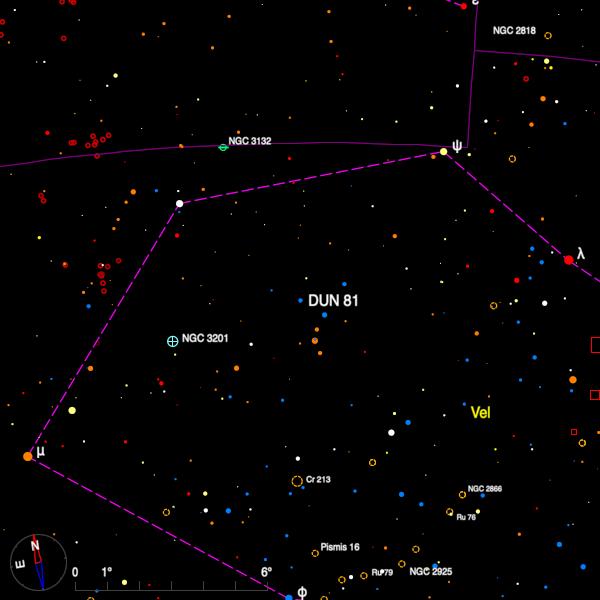
These are distant stars but the parallax of each star suggests that they are related. The Gaia Data Release 3 (Gaia DR3) catalogue gives 1124 ± 6 and 1136 ± 16 light-years respectively for A and B, with similar proper motions. The primary is a B5 dwarf according to Simbad and whilst no spectral type can be found for B, its almost zero (B-V) colour suggests a hot, young star.
Using a 200" search radius on the Gaia DR3 catalogue shows a number of stars around magnitude 20 at about the same distance as the bright pair although admittedly the errors in the parallaxes are large it may suggest that there is a loose cluster here.
Bob Argyle - Double Star Section Director
February 2024 - Double Star of the Month
S 548 (07 27 40.54 +22 08 29.3) was noted by William Herschel in 1782 and catalogued by him as H V 66. He noted that the stars were very unequal and the larger one was pale red and the smaller one was dusky. The distance was noted as 34" 39'". Little has changed in the relative positions since then with the Washington Double Star catalog (WDS) giving 277 degrees and 35".3 for 2019.
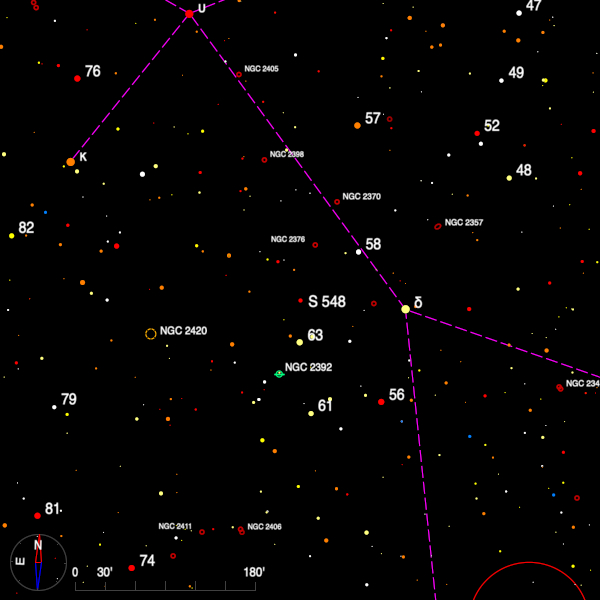
The pair can be found two degrees following delta Gem (see this column for Feb 13). The catalogue magnitudes are 7.0 and 8.9. In 1892 Thomas Espin added a faint companion of magnitude 12.4 at 24 degrees and 11".9. The three stars are unrelated. A lies 1800 light-years away, B is 940 and C is 8350 light-years distant.
In southern Puppis right on the border with Vela is HJ 4093 (08 26 17.74 -39 03 32.3). This is a fine pair for the small aperture, it is triple in apertures of 40-cm or more, whilst the spectrograph reveals that component A is an Algol system called NO Pup.
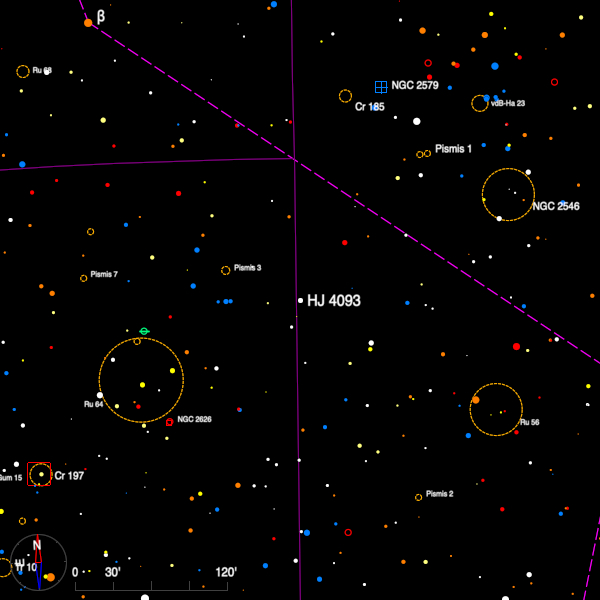
Stars A and B (magnitudes 6.5 and 7.1) are currently at PA 122 degrees and 15".0 having almost doubled their separation since discovery by John Herschel. Using the 26.5-inch refractor at Johannesburg, Willem van den Bos found that B is a close double (Ba,Bb), with stars of magnitude 7.9 and 8.1, currently 0".2 apart and a binary with a period of 103 years. In addition the WDS notes that Andrei Tokovinin finds a close component (D) only 5".4 from A but with a K magnitude of 17.3, but this star does not appear in the Multiple Star Catalogue.
Examining Gaia DR3 with a field of radius 100" shows two stars of magnitudes 12.2 and 13.1 respectively 64" and 66" from A which share the same parallax, so perhaps this is a small cluster. There is, however, no data for the B component and the significant change in the AB distance since discovery may indicate that B is unrelated.
Bob Argyle - Double Star Section Director
January 2024 - Double Star of the Month
Admiral Smyth's Bedford Catalogue contains an entry for 124 Tauri, and from his description of it as a coarse quadruple star of which components B and C are 6".2 apart in PA 318 degrees this appears to agree with Struve's catalogue entry of STF 755 (05 39 09.17 +23 17 17.7).
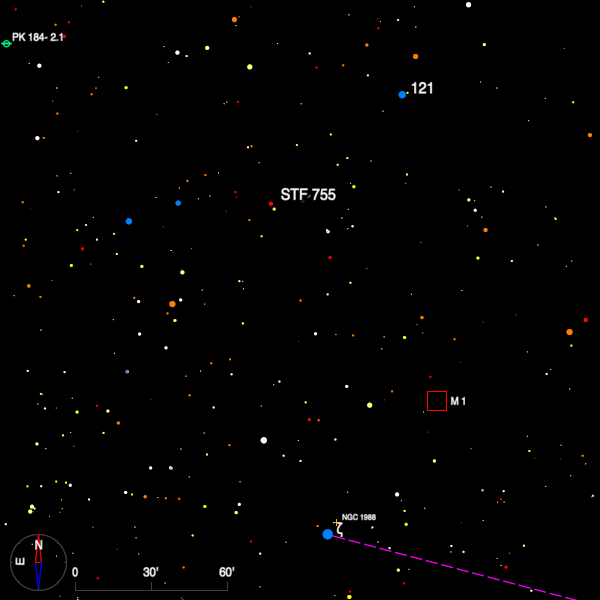
According to the Washington Double Star catalog (WDS) A is magnitude 7.8 at 31 degrees and 149". This is HD 37387, a K2 giant star which appears close to the reflection nebula GN 05.36.2.The fourth star, D, is 50 degrees and 95" from A and has V = 11.1.
There is no label for 124 Tauri in the the Cambridge Double Star Atlas (2nd edition) but the star appears about 30' W of a small right-angled triangle of 6th magnitude stars which in turn sits 2 degrees NNE of zeta Tauri. Smyth happened upon it in 1835 whilst looking for Comet Halley. He gives the colours as garnet (A), pale blue-white (B,C) and bluish (D).
Some 3.5 degrees WSW of epsilon CMa is a triangle of 5th and 6th magnitude stars, the brightest of which is 10 CMa. In the same field, north following is HJ 3891 (06 45 31.20, -30 56 56.3), a double star discovered by John Herschel from the Cape of Good Hope.
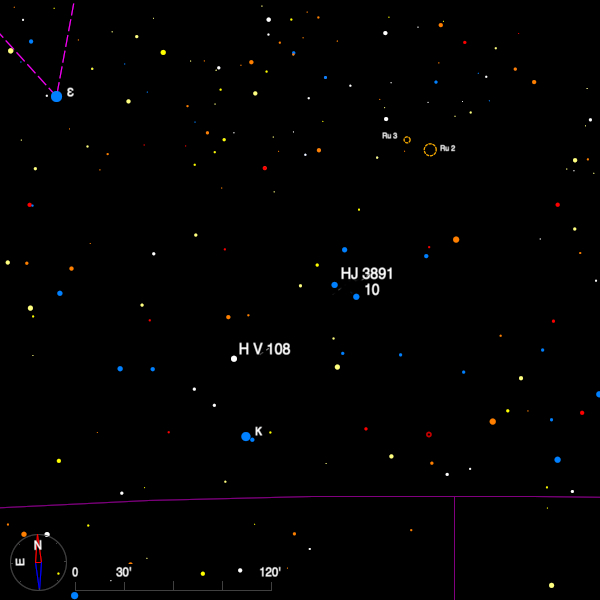
The primary is a B2III star of V = 5.7, and is accompanied by a 8.2 magnitude star at 223 degrees and 5".0. There has been little change since 1838. The stars have similar parallaxes and the mean distance to the system is 1968 light-years. The primary star is also called HP CMa.
Just 90 arc-minutes to the SE is a wide pair swept up by the elder Herschel in 1782. H V 108 has stars of similar brightness (5.8 and 7.7) but they are separated by 43" in PA 66 degrees. The A component has a particularly close and faint companion just 0".6 away which was discovered from Robert Rossiter in South Africa, whilst the WDS notes that the B star has a variable radial velocity. Andrei Tokovinin regards this as a physical quadruple - the brighter stars appear in Gaia DR3 with respective distances of 634 and 623 light-years.
Bob Argyle - Double Star Section Director